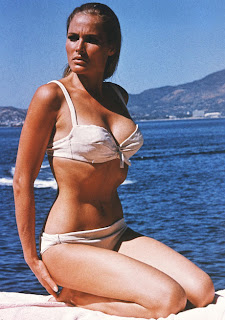Following on fron The Gaze seminar I thought I'd look on the opposite side of the coin and look at women who kind of defied cultural norms and went against the expected perceptions of being just objects of desire who were weak and passive. Sometimes some examples which I'll show in a way kind of embraced this but took it forward.
Ellen Ripley (1979-)
Alien movie series. Assertive figure.
Ripley is first introduced in Alien in 1979. She played a pivotal character in the movie regardless of the plot elements - she plays a warrant officer and first class Lieutenant. A position of power and reputation. An extra-terrestrial alien makes it's way onto the ship and kills all her crew members except fo Ripley. Ripley was probably one of the first times a woman played a central role of the protagonist in an action-orientated role and challenged perceptions. There was a lot more to her than just a pretty face after attention.
Feminist Susan Faludi writes of Ripley in Backlash that, "The tough-talking space engineer who saves an orphan child in Aliens is sympathetically portrayed, but her willfulness, too, is maternal; she is protecting the child - who calls her 'Mommy' - from female monsters."
Entertainment Weekly ranked Ripley 5th on their list of The 20 All Time Coolest Heroes in Pop Culture, calling her "one of the first female movie characters who isn't defined by the men around her, or by her relationship to them"
Watching the film there are some scenes such as when she dresses down to just her underwear, where the camera work really seems to accentuate the notion that she's undressed and looking at the bigger picture, there's not really much need for this scene. It's not essential, it's arguable it could be a reference to the expected perceptions of women in movies compared to what we just witnessed beforehand, which was Ripley battling an alien on her own.
Ripley was one of the first times a woman in a movie was the central heroic figure defying the odds instead of being a damsel in distress. It set a precedent for female figures to come.
Bond girls (1962-present)
Generally passive figures.
Bond girls are a traditional feature of pretty much every Bond movies. I think the role given to Bond girls has changed over time as attitudes towards women has slightly changed. In the past, they were pretty much objects of desire, with no real purpose in the plot and no real aid to James Bond. Bond often just had relations with them and then carried on doing his job. In more recent ones the Bond Girls are perhaps more substantial to the plot but still nowhere near as important enough to be a supporting or secondary protagonist/antagonist.
Even the notion of being a 'bond girl' itself is a topic worthy of discussing itself. Famous movie stars and models aspire to be labelled a 'bond girl'. Not an actress, or a supporting actress but a bond girl. Many times, the actress in question is probably better known as a 'bond girl' than her actual name itself.
Let's compare early Bond Girl names to more recent ones
Honey Ryder - Dr No - 1962
Pussy Galore - Goldfinger - 1964
To more recent Bond Girls
Dr. Christmas Jones - The World Is Not Enough - 1999
Severine - Skyfall - 2012
Overall, these characters play a pretty small part of the plot and are often not in it for long and often are there to be objects for James Bond. One or two of these are actually killed off without having much of a say in the plot.
Lara Croft
Tomb Raider series
Assertive figure
Lara Croft came to prominence in the mid 90's as the star and hero of the Tomb Raider adventure and platform gaming series. Being a sort of female Indiana Jones, Lara Croft was pretty much the first time a woman was the central figure in an action video game. Pretty much how Ripley was in movies.
What's interesting about Lara Croft is she's assertive and challenges our gaze, often appearing in adverts and posters staring right at us and actually attempting to be sexually appealing and inviting but at the same time dominant and assertive. It's almost as if the character addressed and embraces previous historical ideas of the gaze and takes them forward as an asset, not a detrement to the character. In turn, Lara Croft has become a video game and pop culture icon of the 90s, spawning a movie franchise along with it and numerous endorsements with brands such as Lucozade.
"There was something refreshing about looking at the screen and seeing myself as a woman. Even if I was performing tasks that were a bit unrealistic… I still felt like, Hey, this is a representation of me, as myself, as a woman. In a game. How long have we waited for that?"
(Nikki Douglas in Cassell and Jenkins 1999)
"Lara's phenomenal success wasn't just about a cracking adventure, other games had that too. Lara had something that hooked the gamers like nothing has before. At the center of Tomb Raider was a fantasy female figure. Each of her provocative curves was as much part of the game as the tombs she raided. She had a secret weapon in the world of gaming, well... actually two of them"
(Lethal & Loaded, 8.7.01)
"It is clear that the producers of Lara wanted to market her as a characterpotentially appealing to women; her arrival on the game scene dovetailed nicely with the 90's "girlpower" zeitgeist and could potentially have hit a positive chord with the emergent "laddette" culture which very much centred around playing "lads" at their own game"
- Helen W. Kennedy
Lara Croft: Feminist Icon or Cyberbimbo?













No comments:
Post a Comment